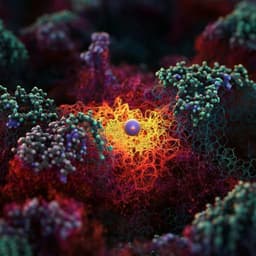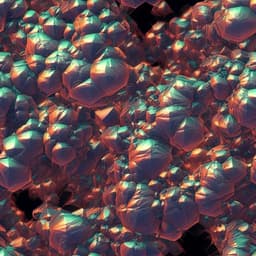
Engineering and Technology
Manipulating the diffusion energy barrier at the lithium metal electrolyte interface for dendrite-free long-life batteries
J. Pokharel, A. Cresce, et al.
This groundbreaking research conducted by Jyotshna Pokharel, Arthur Cresce, and their colleagues reveals a novel solution-processed method for creating a high-performance, Li₃N-rich solid electrolyte interphase (SEI) on lithium metal electrodes, significantly enhancing lithium-ion transport and mechanical stability. Discover how this advancement could transform the future of lithium metal batteries!
~3 min • Beginner • English
Introduction
The rapidly growing demand for high-energy rechargeable batteries for electronics, electric vehicles, and grid storage motivates development beyond conventional Li-ion batteries. Lithium metal anodes promise high specific capacity and low potential but suffer from dendritic Li growth, continued electrolyte decomposition, and low Coulombic efficiency, causing poor reversibility and safety risks. Prior strategies include interfacial engineering, electrolyte design, stable host structures, and modified separators. Fundamentally, dendrite formation is linked to inhomogeneous, fragile SEIs and uneven current distribution; diffusion models (e.g., Sand’s equation and Chazalviel’s framework) capture aspects of concentration polarization but do not fully represent interphase-governed systems. Lowering the Li+ diffusion energy barrier at the interface and increasing Li+ transference number are hypothesized to homogenize ion flux and suppress dendrites. Existing approaches to high transference number (polymer single-ion conductors and ceramic electrolytes) suffer from either low conductivity/mechanics (polymers) or poor interfacial contact and brittleness (ceramics). The study proposes an artificial SEI produced by reacting tetramethylethylenediamine (TEMED) with Li metal to form phase-pure, highly oriented α-Li3N that simultaneously offers low Li+ migration energy barrier, high Li+ transference number, and high modulus, to realize uniform, dendrite-free Li plating/stripping and improved cycling stability in both symmetric and full cells.
Literature Review
The paper surveys prior approaches to stabilize Li metal anodes: interfacial engineering, electrolyte engineering, designing stable hosts to mitigate volume change, and separator modifications. It discusses limitations of diffusion-only models (Sand’s equation; Chazalviel’s diffusion-limited aggregation) for systems with SEIs. It highlights the importance of Li+ transference number and diffusion barriers for interfacial ion transport. Single-ion-conducting polymers provide high transference numbers but often lack mechanical strength and ionic conductivity; ceramic electrolytes provide high transference number yet face poor solid-solid contact and brittleness, limiting practical performance without high stack pressure. Multiple recent works seek to reduce interfacial diffusion barriers and redistribute Li-ion flux via materials and interfacial designs, but challenges remain in simultaneously achieving high Li+ mobility and robust mechanics at the Li/electrolyte interface.
Methodology
Artificial SEI formation: Lithium metal chips (15.6 mm diameter, 450 µm thick) were fully immersed in TEMED in a petri dish (overnight, with optimization at 6, 12, and 18 h). Post-treatment drying at 60 °C for 30 min. SEI thicknesses were characterized by cross-sectional SEM: ~5 µm (6 h), ~10 µm (12 h), ~20 µm (18 h).
Characterization: Contact angle measurements assessed electrolyte wettability on untreated and TEMED-treated Li. XRD identified phase-pure α-Li3N with strong (001)/(002) peaks and preferred orientation; TEM confirmed single-crystalline α-Li3N; XRD after 100 cycles confirmed phase stability. XPS (Li 1s, N 1s, O 1s) and EDS mapped composition, confirming Li3N presence only on treated Li and absence of other organic moieties. AFM mapped topography (RMS roughness) and Young’s modulus.
Electrochemical measurements: Electrochemical impedance spectroscopy (EIS) assessed interfacial and charge-transfer resistances for Li||Li symmetric cells (untreated vs TEMED-treated). The Li+ transference number at the Li/electrolyte interface was measured by the Bruce–Vincent method using symmetric cells: conditioning cycles at 0.01 mA cm−2 (4 h charge/30 min rest/4 h discharge, repeated 6×), followed by 10 mV DC polarization for 10 h; EIS before/after polarization used to compute t+ via t+ = Ii(ΔV − IsRs) / Is(ΔV − IiRi). The Li conductivity of treated Li was estimated from series resistance of symmetric cells.
Electrochemical testing protocols: Symmetric cells (Li||Li and TEMED-Li||TEMED-Li) in 1 M LiTFSI in DOL/DME (1:1 vol) with 1 wt% LiNO3; also commercial 1 M LiPF6 in EC/DEC (1:1) for comparison. Plating/stripping at 0.5–5 mA cm−2 with areal capacities 1–3 mAh cm−2; monitoring voltage profiles, hysteresis, and cycling life. Li||Cu half-cells evaluated CE at 1 mA cm−2 (1 and 3 mAh cm−2) using 50 µm Li. Post-cycling morphology characterized by SEM after 5, 20, and 100 cycles.
Full cells: LFP and NMC-111 positive electrodes fabricated by slurry casting (active:Super-P:PVDF = 80:10:10 in NMP) on Al foil; dried and punched (12 mm). Areal mass loading ~2.0 mg cm−2 (LFP), ~2.5 mg cm−2 (NMC); a high-loading LFP case ~9.5 mg cm−2 was also tested. Full cells used LiTFSI in DOL/DME (1% LiNO3). Cycling at 160 mA g−1 (1C); rate tests at 80, 160, 320, 800 mA g−1.
Phase-field simulations: Implemented in COMSOL using time-dependent general PDE, Nernst–Planck, and current continuity equations with Dirichlet boundary conditions for concentration and potential; zero-flux for phase-field variable. Model domain 500 × 500 µm2. Initial conditions: electrolyte with cLi = 1.0 mol L−1; a semicircle random surface perturbation seeded dendrite growth. Diffusivities: electrolyte Dl ≈ 3.05 × 10−10 m2 s−1 (4.6 × 10−10 cm2 s−1), electrode Ds ≈ 3.1 × 10−13 m2 s−1 (4.6 × 10−13 cm2 s−1). Artificial SEI diffusivity Di scaled to experimental activation energies: ~3× Dl for N2-treated and ~10× Dl for TEMED-treated; simulations compared untreated, N2-treated, and TEMED-treated cases over 100–400 s, tracking Li+ concentration and electric field at dendrite tips.
DFT calculations: VASP with PAW and PBE-GGA, 500 eV cutoff, 3×3×3 α-Li3N supercell (108 atoms), 2×2×2 k-point mesh. Li diffusion pathways and migration barriers computed using climbing-image NEB on a Li-vacancy supercell; results linked to experimentally observed low activation energies and anisotropic conductivity of α-Li3N.
General cell assembly/testing: CR2032 coin cells in Ar glovebox (<0.1 ppm H2O/O2); Celgard 2500 separator; electrolyte volume ~60 µL. All tests at 25 °C.
Key Findings
- TEMED treatment forms a phase-pure, highly oriented α-Li3N artificial SEI on Li metal with full surface coverage after 12–18 h; average SEI thicknesses: ~5 µm (6 h), ~10 µm (12 h), ~20 µm (18 h).
- Wettability: Contact angle decreases from ~41° (untreated Li) to ~12° (TEMED-treated), indicating improved electrolyte wetting and interfacial ion transport.
- Interfacial resistance and conductivity: Li||Li symmetric cell resistance ~400 Ω (untreated) vs ~200 Ω (TEMED-treated). Calculated Li conductivity of TEMED-treated Li ~4.19 × 10−4 mS cm−2 (from series resistance), enabling fast interfacial Li exchange.
- Li+ transference number: TEMED-treated t+ ≈ 0.668 vs untreated ≈ 0.37 (Bruce–Vincent), indicating significantly higher cationic contribution to ion flux across the interface.
- Activation energy for interfacial diffusion (Arrhenius analysis): untreated ~0.703 eV; N2-treated ~0.613 eV; TEMED-treated ~0.48 eV, correlating with enhanced Li+ mobility and reduced concentration gradients across the SEI.
- AFM and mechanics: Surface roughness RMS reduced from ~242 nm (untreated) to ~157 nm (TEMED-treated). Average Young’s modulus increases from ~0.32 GPa (untreated) to ~6.85 GPa (TEMED-treated), exceeding the ~6 GPa threshold to mechanically suppress dendrite growth; attributed to oriented α-Li3N.
- Symmetric cell durability: At 0.5 mA cm−2 and 1 mAh cm−2, untreated short-circuits ~600 h; TEMED-treated remains stable >3500 h with <20 mV hysteresis. At 1 mA cm−2, TEMED-treated stable >1000 h (~500 cycles) vs untreated fails ~400 h. At higher currents: 2 mA cm−2, ~700 h (treated) vs ~150 h (untreated); 5 mA cm−2, ~350 h (treated) vs ~50 h (untreated). In LiPF6 EC/DEC electrolyte, TEMED-treated stable >750 h at 1 mA cm−2 vs ~270 h untreated.
- Nucleation overpotential: Reduced from ~37 mV (untreated) to ~15 mV (TEMED-treated), indicating higher lithiophilicity and lower nucleation barrier.
- Morphology: SEM after cycling shows untreated Li develops dendritic, porous morphologies; TEMED-treated Li maintains dense, nodule-like, compact deposits without discernible dendrites even after 100 cycles.
- Phase-field simulations: High-diffusivity SEI (mimicking α-Li3N) homogenizes Li+ concentration and reduces the electric field amplification at protrusions (maximum Ex reduced by ~2× vs N2-treated and ~3× vs untreated), suppressing dendrite growth.
- Full-cell performance: LFP-based full cells at 160 mA g−1 show stable capacity with TEMED-treated Li, while untreated degrades linearly. Rate capability: TEMED-treated retains and recovers capacity across 80–800 mA g−1; untreated loses capacity at high rates. High-loading LFP (~9.5 mg cm−2): ~74% capacity retention at 50 cycles (treated) vs ~50% (untreated). NMC-111: ~73% capacity retention (treated) vs ~48% (untreated) after 200 cycles. Lower overpotentials observed with TEMED-treated Li full cells.
- Structural stability: XRD after 100 cycles retains strong α-Li3N (001)/(002) peaks, evidencing robust phase stability of the TEMED-derived SEI.
Discussion
The study addresses the hypothesis that simultaneously lowering the Li+ diffusion energy barrier and increasing the Li+ transference number at the Li/electrolyte interface, while providing robust mechanical strength, can suppress dendritic growth and stabilize Li metal anodes. TEMED-derived, phase-pure, oriented α-Li3N SEI demonstrably reduces activation energy for Li+ transport and elevates t+, leading to enhanced interfacial diffusivity and more uniform Li+ concentration profiles. AFM modulus mapping shows a >20× increase in Young’s modulus relative to untreated Li, mitigating morphological instabilities and resisting SEI rupture during volume changes. Phase-field simulations corroborate experiments: a high-diffusivity SEI reduces electric field focusing and concentration gradients at protrusions, preventing self-accelerating dendrite growth. Consequently, symmetric cells exhibit dramatically extended lifetimes with low hysteresis across a wide range of currents and capacities, and full cells (LFP, NMC) show improved capacity retention, rate capability, and reduced polarization. The results link interfacial transport properties (diffusivity, t+) and mechanical robustness to dendrite suppression and cycling stability, validating the proposed design principles for artificial SEIs.
Conclusion
A simple, scalable solution process using TEMED creates a phase-pure, highly oriented α-Li3N artificial SEI on Li metal that combines low Li+ migration barrier, high Li+ transference number, and high modulus. This engineered interphase homogenizes Li+ flux, reduces nucleation overpotential, and suppresses dendritic and dead Li formation, yielding long-life symmetric cells (>3500 h at 0.5 mA cm−2) and robust full-cell performance with LFP and NMC cathodes, including under high-rate and higher-loading conditions. The integrated experimental, simulation, and DFT results establish the mechanistic basis for performance gains and provide a blueprint for designing artificial SEIs with co-optimized ion transport and mechanics. Future work could optimize SEI thickness/processing for minimal impedance with complete coverage, explore compatibility across broader electrolytes and cathode chemistries, and extend to lean-electrolyte and anode-free cell formats.
Limitations
Related Publications
Explore these studies to deepen your understanding of the subject.







